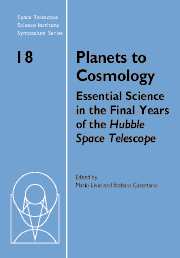 Planets to Cosmology
Planets to Cosmology Book contents
- Frontmatter
- Contents
- Participants
- Preface
- Hubble's view of transiting planets
- Unsolved problems in star formation
- Star formation in clusters
- HST abundance studies of low metallicity stars
- Physical conditions and feedback: HST studies of intense star-forming environments
- Quasar hosts: Growing up with monstrous middles
- Reverberation mapping of active galactic nuclei
- Feedback at high redshift
- The baryon content of the local intergalactic medium
- Hot baryons in supercluster filaments
- Galaxy assembly
- Probing the reionization history of the Universe
- Studying distant infrared-luminous galaxies with Spitzer and Hubble
- Galaxies at z ≈ 6–i′-drop selection and the GLARE Project
- The Hubble Ultra Deep Field with NICMOS
Studying distant infrared-luminous galaxies with Spitzer and Hubble
Published online by Cambridge University Press: 17 August 2009
- Frontmatter
- Contents
- Participants
- Preface
- Hubble's view of transiting planets
- Unsolved problems in star formation
- Star formation in clusters
- HST abundance studies of low metallicity stars
- Physical conditions and feedback: HST studies of intense star-forming environments
- Quasar hosts: Growing up with monstrous middles
- Reverberation mapping of active galactic nuclei
- Feedback at high redshift
- The baryon content of the local intergalactic medium
- Hot baryons in supercluster filaments
- Galaxy assembly
- Probing the reionization history of the Universe
- Studying distant infrared-luminous galaxies with Spitzer and Hubble
- Galaxies at z ≈ 6–i′-drop selection and the GLARE Project
- The Hubble Ultra Deep Field with NICMOS
Summary
New surveys with the Spitzer Space Telescope identify distant star-forming and active galaxies by their strong emission at far-infrared wavelengths, which provides strong constraints on these galaxies' bolometric energy. Using early results from Spitzer surveys at 24 μm, we argue that the faint sources correspond to the existence of a population of infrared-luminous galaxies at z ≳ 1 that are not expected from predictions based on previous observations from ISO and IRAS. Combining Spitzer images with deep ground-based optical and Hubble Space Telescope imaging, we discuss the properties of galaxies selected at 24 μm in the region of the Chandra Deep Field South, including redshift and morphological distributions. Galaxies with z ≲ 1 constitute roughly half of the faint 24 μm sources. Infrared-luminous galaxies at these redshifts span a wide variety of normal to strongly interacting/merging morphologies, which suggests that a range of mechanisms produce infrared activity. Large-area, joint surveys between Spitzer and HST are needed to understand the complex relation between galaxy morphology, structure, environment, and activity level, and how this evolves with cosmic time. We briefly discuss strategies for constructing surveys to maximize the legacy of these missions.
Introduction
Infrared (IR) luminous galaxies represent highly active stages in galaxy evolution that are not generally inferred in optically selected galaxy surveys (e.g., Rieke & Low 1972; Soifer, Neugebauer, & Houck 1987).
- Type
- Chapter
- Information
- Planets to CosmologyEssential Science in the Final Years of the Hubble Space Telescope: Proceedings of the Space Telescope Science Institute Symposium, Held in Baltimore, Maryland May 3–6, 2004, pp. 174 - 184Publisher: Cambridge University PressPrint publication year: 2006


